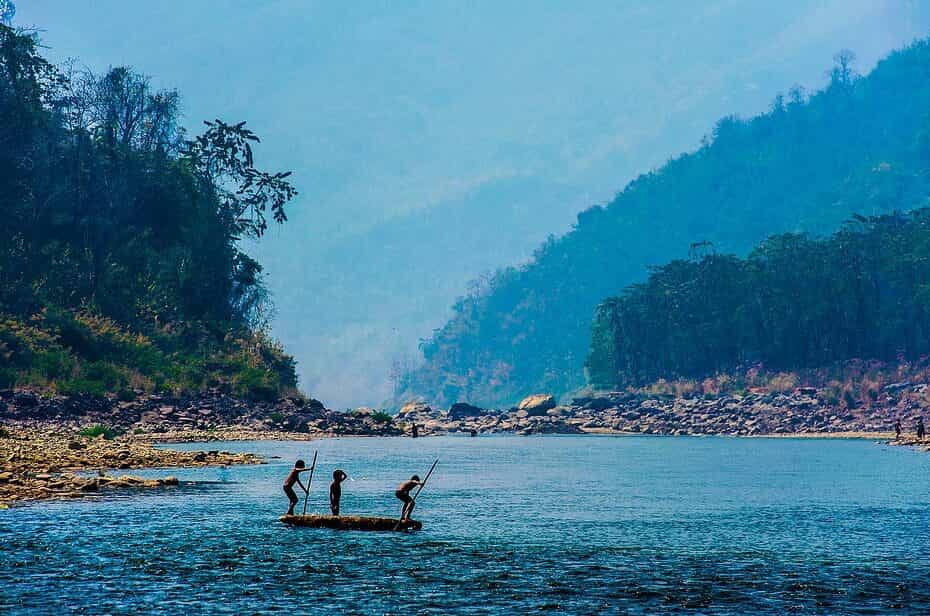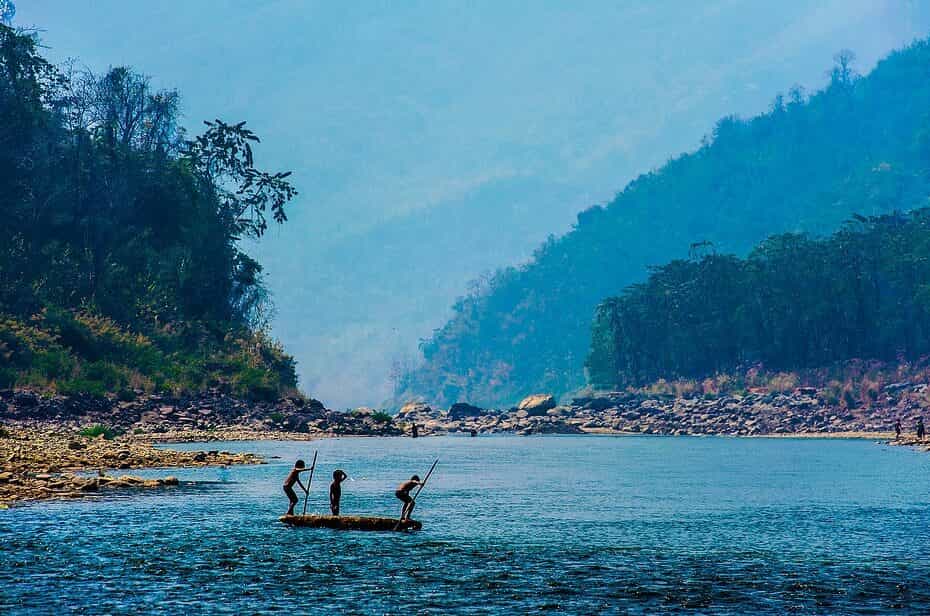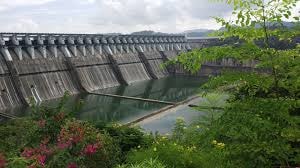With a vast network of large rivers of several civilizations over the centuries, India is regarded as the land of rivers. Several ancient civilizations thrived on the river banks in India. Not only do these rivers enrich agriculture and enhance the lifeline for Indians, but also they play a major role in Hindu mythology. As a matter of fact, most of the rivers in India are sacred by Hindus as they are considered holy in the form of gods and goddesses.
Since the largest rivers have the potential for constructing massive dams, India has approximately over 4300 large dams spread across the 400 rivers in the country. Henceforth, in the following article, we provide details about the top 10 longest rivers and largest dams in India.
Rivers in India
A river is a body of water that flows towards the sea, ocean, lake, or another river. On that account, rivers in India can be divided according to the source. This indicates that there are two types of rivers namely the Himalayan rivers and Peninsular rivers. The latter are rain-fed including those rising from the Western Ghats; whereas the former are perennial in nature. Moreover, Rivers that flow into the sea are sorted geographically. 90 percent flow towards the coast discharging from the Bay of Bengal in the east, the rest 10 percent flows towards the Indian coast southward to Kanyakumari, then northward draining in the Arabian Sea.
Importance of Rivers
In terms of river systems benefits, they vary and differ according to use reasons. Some of the advantages of the major rivers in India are presented as follows:
- They provide irrigation and potable water
- They offer cheap transportation,
- They equip electricity,
- They also supply livelihoods for a big number of people all over the country.
It should be noted that most of the agricultural lands are being irrigated from the waters taken from the rivers. This explains why all the major cities of India are located by the river banks.
List of Top 10 Longest Indian Rivers
-
Indus River (3180 km)

The Indus river is one of the mightiest rivers in Asia and it holds a mythical and historical significance for India. As a matter of fact, not only is it regarded as the birthplace of the Indus Valley Civilization but also the name of the country ‘India’ is derived from it. In terms of distance, Indus covers a long area starting from its source in the Himalayas’ northwestern foothills, particularly in Tibet near Manasarovar lake, it flows through the Jammu & Kashmir state along Pakistan, and finally empties in the Arabian Sea.
-
Brahmaputra River (3848 km)
This river is commonly known as the ‘Lifeline of Assam’. It is considered as one of the most essential rivers in the region as it offers transportation and irrigation in the state. The water from the Brahmaputra river starts at the Himalayas ‘Angsi Glacier which is located near the Mansarovar lake, flows through Tibet into Arunachal Pradesh, to the southwest, into Assam, and then through Bangladesh where it drains into the Bay of Bengal. This river has major tributaries on its right banks such as Kameng, Sankosh, and Manas; as well as some on the left bank including Kalang, Dhansari, and Dihing.
-
Yarlung Tsangpo River (2840 km)

This river is one of the biggest rivers in Tibet known as the roof of the world. It starts from its source on Gyima Yangzong Glacier and flows within the Indian state Arunachal Pradesh in the northeast. Moreover, the Yarlung Tsangpo river holds a great position being the highest altitude river across the world. In addition, the rive has one of the longest and deepest canyons in the world named after it that was formed in the northern foothills of the Himalayas.
-
Ganga River (2704 km)
It is a trans-boundary river that originates from the western Himalayas and runs through the Gangetic Plain to empty in the Bay of Bengal, in Bangladesh. This mighty river is one of the most important rivers in northern India that contains civilizations banks. Within it resides nearly 90 water species such as Gharial, as well as almost 140 different fish species. The most famous tributaries of the Ganga river are the Alaknanda river and the Bhagirathi river. In addition, Gaumukh being the source of the Ganga river is a worshipped place by the Hindus as Goddess Ganga.
-
Godavari River (1465 km)

The Godavari river is one of the longest Indian rivers forming one of the largest river basins in the world. This river originates from the Trimbakeshwar in Nashik and flows on a path towards Telangana and Andhra Pradesh while passing via Chhattisgarh till meeting the end with the Bay of Bengal. On another note, it is regarded as a sacred waterway by the Hindus as it has the largest mangrove formation in the country. In fact, it still continues to harbor a rich cultural history and heritage after being revered in Hindu scriptures for many decades.
-
Sutlej River (1450 km)
The Sutlej river rises on the Himalayas’ north slope in southwestern Tibet, and it flows through northern Indian states as well as China and Pakistan. However, the majority of this river is in the latter. In fact, it travels through crossroads of Punjab, Pakistan; and North India then eventually joins Chenab and merges with Indus. In this case, it is the longest river from the five tributaries of the Indus River. Besides, it contains various hydroelectric plants that are used in order to generate electricity for the residents due to its very fast flow.
-
Krishna River (1400 km)

The Krishna river is a major source of water utilities including irrigation in the Southern Indian states. The river starts at a small town in the state of Maharashtra named Mahabaleshwar and flows through Telangana, Maharashtra, Andhra Pradesh, and Karnataka states entering the Bay of Bengal. Furthermore, Krishna supports rich wildlife as it contains several dams built in different cities in order to provide drinking water and generate electricity. Besides, during the monsoon season, the areas surrounding the river are prone to soil erosion. The largest tributaries of this river are the Bhima River and the Tungabhadra River.
-
Yamuna River (1376 km)
Yamuna river is the longest tributary of Ganges River that begins from the Yamunotri glacier at Uttarkashk’s Banderpoonch peak in Uttarakhand. The river, then, flows through the Uttarakhand states among which Delhi, Himachal Pradesh, Haryana, as well as Uttar Pradesh. At the end of the journey, Yamuna merges with Ganga at Triveni Sangam, Uttar Pradesh but it does not fall into the sea directly.
-
Gadilam River (1334 km)
Gadilam, also called the Kedilam river, is a river that is known for flourishing and fulfilling inhabitants’ natural needs. It is located in the southern part of the country, in the Indian state Tamil Nadu. This river flows through the Cuddalore’s town and separates Thirupadiripuliyur from the old town then draining into the Bay of Bengal. Further, Thiruvathigai is one of the famous temples located in the Gadilam river banks.
-
Narmada River (1312 km)
The Narmada river is unique as it is regarded as one of the holiest rivers according to the Hindu religion. In fact, it is believed to be a heavenly waterway and it is worshipped as a goddess. Moreover, the river is a peninsular one that starts from the Amarkantak mountain range in Madhya Pradesh, Narmada Kund, flowing westward through Maharashtra, Madhya Pradesh, and Gujarat; then draining into the Arabian Sea. Also, it is the origin of many waterfalls supporting rich wildlife.
Dams in India
Dams are built on the large rivers as barriers or structures across the waterway. It is built to both confine and control water’s flow. Furthermore, they are categorized according to their structure or intended purpose. The latter involves power generation, irrigation, multipurpose, and so on; however, the former includes arch, gravity, embankment, etc. As a matter of fact, multipurpose dams hold an essential role in developing countries. As of now, some dams in India bring significant benefits among which rich tourism places, beautiful views, tranquility, peace, and adventure.
Importance of Dams
In technical terms, dams store water in the reservoir during times of water flow excess. Later, they release water when the flow is low to meet water demand and create a natural flow. The largest dams in India have aided the inhabitants in several ways among which:
-
-
- Providing adequate water for industry, domestic, and other irrigation purposes.
- Providing hydroelectric power production
- River navigation as it is the cheapest form of transportation.
- Offering recreation fishing and boating areas.
- Helping in the reduction of floods and providing flows when needed.
-
List of Top 10 Largest Dams in India
-
-
-
Tehri Dam
-
-
This dam is the 8th highest dam in the world and it is the highest one in India. It was first built in 2006 to provide water for generating electricity, providing drinkable water, and for irrigation purposes.
Length: 575 m / Height: 261 m
River: Bhagirathi River
Location: Uttarakhand
-
-
-
Bhakra Nangal Dam
-
-
It is the highest dam in India after Tehri. As a matter of fact, it was a part of a multipurpose project that aims to prevent floods caused by the Sutlej river valley; as well as tourism, agriculture, and several other purposes.
Length: 520 m /Height: 226 m
River: Sutlej River
Location: Himachal Pradesh
-
-
-
Hirakud Dam
-
-
After India’s independence, the Hirakud dam is considered as one of the first main multipurpose river valley projects undertaken at that time. In fact, it holds a great historical and agricultural importance in the country.
Length 25.8 km / Height: 61 m
River: Mahanadi River
Location: Odisha
-
-
-
Nagarjuna Sagar Dam
-
-
This dam is a masonry dam that was created between 1955 and 1967. It is considered as one of the main sites that hold water streams during peak flood season by opening its gates to the Pulichintala project.
Length: 1450 m / Height: 124 m
River: Krishna River
Location: Telangana/Andhra Pradesh
-
-
-
Sardar Sarovar Dam

-
-
This concrete gravity dam is an electric power supplier and irrigation provider for four states namely Gujarat, Maharashtra, Madhya Pradesh, and Rajasthan.
Length: 1210 m / Height: 163 m
River: Narmada River
Location: Gujarat
-
-
-
Koyna Dam
-
-
This rubble-concrete dam has one of the major hydroelectric power projects in India. The Koyna dam holds a total capacity of 2,797,400,000 m3 making it the generator of nearly 2,000 MW of power.
Height: 103.2 m / Length: 807.2 m
River: Biradar river
Location: Koyna Nagar, Maharashtra
-
-
-
Indira Sagar Dam
-
-
The Indira Sagar dam is Madhya Pradesh’s main multipurpose project. It was constructed in 1992 on the Narmada river. Also, the reservoir of this dam is the main water source for electricity and irrigation for the western area.
Height: 92 m / Length: 653 m
River: Narmada river
Location: Punasa, Madhya Pradesh
-
-
-
Rihand Dam
-
-
The Rihand dam is a prestigious hydroelectric power plant in India that was built in October 1984. This multipurpose dam holds 12,200,000,000 m3 which makes it the largest reservoir in the country.
Height: 91.46 m / Length: 934.45 m
River: Rihand river
Location: Sonbhadra, Uttar Pradesh
-
-
-
Mettur Dam
-
-
It is considered as one of the largest dams in India built in 1934. Mettur is one of the primary electricity sources for the state of Tamil Nadu. The Tamil Nadu Electricity Board (TNEB) allows the Mettur Thermal Power Station to act as a power plant’s baseload.
Height: 65 m / Length: 1,700 m
River: Kaveri river
Location: Salem District, Tamil Nadu
-
-
-
Krishna Sagar Dam
-
-
The Krishna Sagar dam (also known as KRS), was firstly opened in 1932 in Karnataka. Not only is it a place of agriculture but it is also a major attraction for tourists.
Height: 39.8 m / Length: 2,620 m
River: Kaveri river
Location: Mandya, Karnataka
Taking everything into consideration, India is indeed a land of rivers with numerous large rivers flowing from and to the country. The vast network of rich rivers enables the country to have several benefits in terms of agriculture, electricity, and even tourism. As this article discusses the top 10 longest rivers and largest dams in India, it draws upon the existence of these major waterways and their advantages for the country and its people.
1 thought on “The Top 10 Longest Rivers and Largest Dams in India”